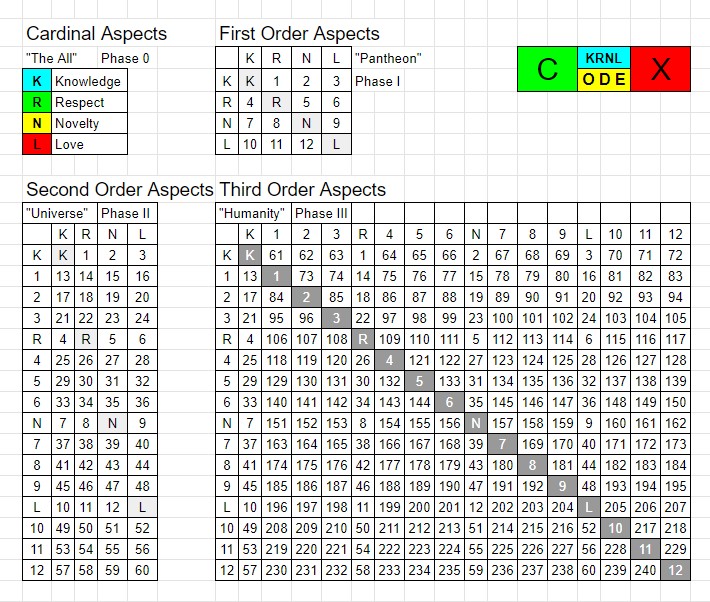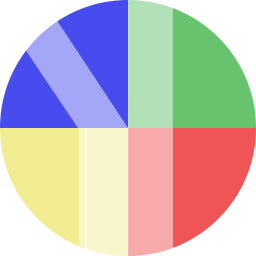It took me a long time to really play with combining aspects. Eventually I opened up a spreadsheet and began creating charts that would help me think about it. What emerged from this is the KRNL Codex, a compendium of charts, diagrams, and tables of correspondences that has been my memetic laboratory while expanding the system.
The first chart is simple enough: a four-by-four grid, with the Cardinal Aspects along either axis. The “base” would be the aspects on the left, being “mixed with” the aspects going across. Leaving out the diagonal, this generates 12 more unique aspects, the First Order Aspects or the “Pantheon,” for how often that number describes the centrally important figures in other traditions.
The Second Order Aspects, or “The Universe,” are generated by mixing these 12 with the initial four to make 48 more, creating an array of 64 total. At this phase I began to appreciate the correspondence with the 64 hexagrams of the I Ching, which as a metaphysical system appears to describe the whole of human and universal dynamics. I looked there for inspiration in how to interpret my own combinations to ensure I’d captured that breadth of cosmic potential. As of this article and the beginning of KRNL Cycle 1, I have a rough selection of these 64 aspects that I will be working to solidify and articulate over the course of the cycle.

The final, complete system of Third Order Aspects, “Humanity,” is a full 16×16 grid with a total of 256 aspects within it. This number was significant for a few reasons. Most obviously, any techie following the computing puns will appreciate the number’s prevalence and importance in the math and software world; geeks have considered it a sacred number for far longer than I have. But for me, it’s been my favorite and lucky number since high school when I started seeing it everywhere, especially on digital clocks at odd moments, becoming a privately enjoyed cognitive bias.
I’ve come to learn that another tradition, the Yoruba religion and divination system Ifá also has a system of 16×16, or 256 core texts that seeks “to reference all situations, circumstances, actions and consequences in life,” a similar intention for the Third Order Aspects. I continue to be surprised and humbled that even when I try to introduce intentionally distinct structure and content to KRNL, I find precedence and correspondence in existing world traditions.
A key end goal for this project, a filled cup of completion that will extinguish the creative flame, will be the realization of the Codex in its fullest form: a fully interactive mobile and web app containing a scaffolded exploration or customization of the entire system; with social elements for commentary, discussion, and play; and a library of sacred texts from the world’s traditions to examine and study in relation. As a matter of devotion I feel compelled to program this myself, so it’s a long-term goal, but still, I do see where this is all going.
I’ve got all kinds of wild ideas that could go into such an app to make it meaningful and entertaining, drawn from the best games, educational tools, and religious text apps I’ve seen. In some ways I’m imagining a digital equivalent to the Orange Catholic Bible from Dune – yet another fictional inspiration – the sacred text for an amalgam of several Earth religions that fused over the millennia, thousands of pages contained in a gadget the size of your thumb.
For now, the Codex remains my alchemical workshop, or perhaps artist studio, as I continue to experiment, brainstorm, and articulate the system. I invite readers to make a copy of the Public KRNL Codex Worksheet and play around with the exercise on their own. I’d love to see and be inspired and enlightened by other solutions!
